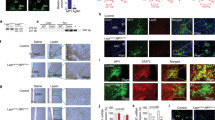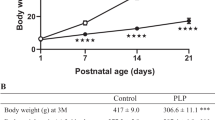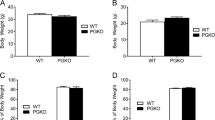Abstract
Background:
Pups of normally nourished dams that are cross-fostered after birth to dams fed a low-protein (8% by weight) diet (postnatal low protein (PLP)) grow slower during the suckling period and remain small and lean throughout adulthood. At weaning, they have increased expression in the arcuate nucleus (ARC) of the hypothalamus of the orexigenic neuropeptide Y (NPY) and decreased expression of pro-opiomelanocortin, the precursor of anorexigenic melanocortins.
Objectives And Methods:
We investigated, using third ventricle administration, whether 3-month-old male PLP rats display altered sensitivity to leptin with respect to food intake, NPY and the melanocortin 3/4-receptor agonist MTII, and using in situ hybridization or laser capture microdissection of the ARC followed by RT-PCR, whether the differences observed were associated with changes in the hypothalamic expression of NPY or the leptin receptor, NPY receptors and melanocortin receptors.
Results:
PLP rats were smaller and had reduced percentage body fat content and plasma leptin concentration compared with control rats. Leptin (5 μg) reduced food intake over 0–48 h more in PLP than control rats (P<0.05). Submaximal doses of NPY increased the food intake less in PLP rats than in controls, whereas submaximal doses of MTII reduced the food intake more in PLP rats. Maximal responses did not differ between PLP and control rats. Leptin and melanocortin-3 receptor (MC3R) expression were increased in both ARC and ventromedial hypothalamic nuclei in PLP animals compared with the controls. MC4R, NPY Y1R, Y5R and NPY expression were unchanged.
Conclusion:
Postnatal undernourishment results in food intake in adult rats being more sensitive to reduction by leptin and melanocortins, and less sensitive to stimulation by NPY. We propose that this contributes to increased leptin sensitivity and resistance to obesity. Increased expression of ObRb and MC3R may partly explain these findings but other downstream mechanisms must also be involved.
This is a preview of subscription content, access via your institution
Access options
Subscribe to this journal
Receive 12 print issues and online access
$259.00 per year
only $21.58 per issue
Buy this article
- Purchase on Springer Link
- Instant access to full article PDF
Prices may be subject to local taxes which are calculated during checkout




Similar content being viewed by others
References
McMillen IC, Robinson JS . Developmental origins of the metabolic syndrome: prediction, plasticity, and programming. Physiol Rev 2005; 85: 571–633.
Druet C, Ong KK . Early childhood predictors of adult body composition. Best Pract Res Clin Endocrinol Metab 2008; 22: 489–502.
Ravelli GP, Stein ZA, Susser MW . Obesity in young men after famine exposure in utero and early infancy. N Engl J Med 1976; 295: 349–353.
de Rooij SR, Painter RC, Phillips DI, Osmond C, Michels RP, Godsland IF et al. Impaired insulin secretion after prenatal exposure to the Dutch famine. Diabetes Care 2006; 29: 1897–1901.
Ong KK, Preece MA, Emmett PM, Ahmed ML, Dunger DB . Size at birth and early childhood growth in relation to maternal smoking, parity and infant breast-feeding: longitudinal birth cohort study and analysis. Pediatr Res 2002; 52: 863–867.
Harder T, Bergmann R, Kallischnigg G, Plagemann A . Duration of breastfeeding and risk of overweight: a meta-analysis. Am J Epidemiol 2005; 162: 397–403.
Ozanne SE, Hales CN . Lifespan: catch-up growth and obesity in male mice. Nature 2004; 427: 411–412.
Cripps RL, Martin-Gronert MS, Archer ZA, Hales CN, Mercer JG, Ozanne SE . Programming of hypothalamic neuropeptide gene expression in rats by maternal dietary protein content during pregnancy and lactation. Clin Sci (Lond) 2009; 117: 85–93.
Velkoska E, Cole TJ, Dean RG, Burrell LM, Morris MJ . Early undernutrition leads to long-lasting reductions in body weight and adiposity whereas increased intake increases cardiac fibrosis in male rats. J Nutr 2008; 138: 1622–1627.
Jimenez-Chillaron JC, Hernandez-Valencia M, Lightner A, Faucette RR, Reamer C, Przybyla R et al. Reductions in caloric intake and early postnatal growth prevent glucose intolerance and obesity associated with low birthweight. Diabetologia 2006; 49: 1974–1984.
Remmers F, Fodor M, Delemarre-van de Waal HA . Neonatal food restriction permanently alters rat body dimensions and energy intake. Physiol Behav 2008; 95: 208–215.
Bouret SG . Early life origins of obesity: role of hypothalamic programming. J Pediatr Gastroenterol Nutr 2009; 48 (Suppl 1): S31–S38.
Grove KL, Grayson BE, Glavas MM, Xiao XQ, Smith MS . Development of metabolic systems. Physiol Behav 2005; 86: 646–660.
Glavas MM, Joachim SE, Draper SJ, Smith MS, Grove KL . Melanocortinergic activation by melanotan II inhibits feeding and increases uncoupling protein 1 messenger ribonucleic acid in the developing rat. Endocrinology 2007; 148: 3279–3287.
Muhlhausler BS, Adam CL, Findlay PA, Duffield JA, McMillen IC . Increased maternal nutrition alters development of the appetite-regulating network in the brain. FASEB J 2006; 20: 1257–1259.
Delahaye F, Breton C, Risold PY, Enache M, Dutriez-Casteloot I, Laborie C et al. Maternal perinatal undernutrition drastically reduces postnatal leptin surge and affects the development of arcuate nucleus proopiomelanocortin neurons in neonatal male rat pups. Endocrinology 2008; 149: 470–475.
Chen H, Simar D, Lambert K, Mercier J, Morris MJ . Maternal and postnatal overnutrition differentially impact appetite regulators and fuel metabolism. Endocrinology 2008; 149: 5348–5356.
Schioth HB, Bouifrouri AA, Rudzish R, Muceniece R, Watanobe H, Wikberg JE et al. Pharmacological comparison of rat and human melanocortin 3 and 4 receptors in vitro. Regul Pept 2002; 106: 7–12.
Paxinos G, Watson C, Pennisi M, Topple A . Bregma, lambda and the interaural midpoint in stereotaxic surgery with rats of different sex, strain and weight. J Neurosci Methods 1985; 13: 139–143.
Turnbull AV, Ellershaw L, Masters DJ, Birtles S, Boyer S, Carroll D et al. Selective antagonism of the NPY Y5 receptor does not have a major effect on feeding in rats. Diabetes 2002; 51: 2441–2449.
Hagan MM, Rushing PA, Pritchard LM, Schwartz MW, Strack AM, Van Der Ploeg LH et al. Long-term orexigenic effects of AgRP-(83–32) involve mechanisms other than melanocortin receptor blockade. Am J Physiol Regul Integr Comp Physiol 2000; 279: R47–R52.
Hwa JJ, Ghibaudi L, Gao J, Parker EM . Central melanocortin system modulates energy intake and expenditure of obese and lean Zucker rats. Am J Physiol Regul Integr Comp Physiol 2001; 281: R444–R451.
Murray JF, Mercer JG, Adan RA, Datta JJ, Aldairy C, Moar KM et al. The effect of leptin on luteinizing hormone release is exerted in the zona incerta and mediated by melanin-concentrating hormone. J Neuroendocrinol 2000; 12: 1133–1139.
Nilaweera KN, Ellis C, Barrett P, Mercer JG, Morgan PJ . Hypothalamic bHLH transcription factors are novel candidates in the regulation of energy balance. Eur J Neurosci 2002; 15: 644–650.
Simmons DM, Arriza JL, Swanson LW . A complete protocol for in situ hybridization of messenger RNAs in brain and other tissues with radio-labelled single-stranded RNA probes. J Histotechnol 1989; 12: 169–181.
Mercer JG, Lawrence CB, Beck B, Burlet A, Atkinson T, Barrett P . Hypothalamic NPY and prepro-NPY mRNA in Djungarian hamsters: effects of food deprivation and photoperiod. Am J Physiol 1995; 269: R1099–R1106.
Jovanovic Z, Tung YC, Lam BY, O’Rahilly S, Yeo GS . Identification of the global transcriptomic response of the hypothalamic arcuate nucleus to fasting and leptin. J Neuroendocrinol 2010; 22: 915–925.
Remmers F, Verhagen LA, Adan RA, Delemarre-van de Waal HA . Hypothalamic neuropeptide expression of juvenile and middle-aged rats after early postnatal food restriction. Endocrinology 2008; 149: 3617–3625.
Abbott CR, Rossi M, Kim M, AlAhmed SH, Taylor GM, Ghatei MA et al. Investigation of the melanocyte stimulating hormones on food intake. Lack of evidence to support a role for the melanocortin-3-receptor. Brain Res 2000; 869: 203–210.
Renquist BJ, Lippert RN, Sebag JA, Ellacott KL, Cone RD . Physiological roles of the melanocortin MC receptor. Eur J Pharmacol 2011; 660: 13–20.
Scarpace PJ, Matheny M, Zhang Y, Tumer N, Frase CD, Shek EW et al. Central leptin gene delivery evokes persistent leptin signal transduction in young and aged-obese rats but physiological responses become attenuated over time in aged-obese rats. Neuropharmacology 2002; 42: 548–561.
Arch JR . Central regulation of energy balance: inputs, outputs and leptin resistance. Proc Nutr Soc 2005; 64: 39–46.
Enriori PJ, Evans AE, Sinnayah P, Jobst EE, Tonelli-Lemos L, Billes SK et al. Diet-induced obesity causes severe but reversible leptin resistance in arcuate melanocortin neurons. Cell Metab 2007; 5: 181–194.
Hansen MJ, Ball MJ, Morris MJ . Enhanced inhibitory feeding response to alpha-melanocyte stimulating hormone in the diet-induced obese rat. Brain Res 2001; 892: 130–137.
Scarpace PJ, Matheny M, Zolotukhin S, Tumer N, Zhang Y . Leptin-induced leptin resistant rats exhibit enhanced responses to the melanocortin agonist II MT. Neuropharmacology 2003; 45: 211–219.
Li G, Zhang Y, Wilsey JT, Scarpace PJ . Unabated anorexic and enhanced thermogenic responses to melanotan II in diet-induced obese rats despite reduced melanocortin 3 and 4 receptor expression. J Endocrinol 2004; 182: 123–132.
Zhang Y, Matheny M, Tumer N, Scarpace PJ . Aged-obese rats exhibit robust responses to a melanocortin agonist and antagonist despite leptin resistance. Neurobiol Aging 2004; 25: 1349–1360.
van Dijk G, de Vries K, Nyakas C, Buwalda B, Adage T, Kuipers F et al. Reduced anorexigenic efficacy of leptin, but not of the melanocortin receptor agonist melanotan-II, predicts diet-induced obesity in rats. Endocrinology 2005; 146: 5247–5256.
Hansen MJ, Jovanovska V, Morris MJ . Adaptive responses in hypothalamic neuropeptide Y in the face of prolonged high-fat feeding in the rat. J Neurochem 2004; 88: 909–916.
Brown L, Deighton NM, Bals S, Sohlmann W, Zerkowski HR, Michel MC et al. Spare receptors for beta-adrenoceptor-mediated positive inotropic effects of catecholamines in the human heart. J Cardiovasc Pharmacol 1992; 19: 222–232.
Schwartz MW, Seeley RJ, Woods SC, Weigle DS, Campfield LA, Burn P et al. Leptin increases hypothalamic pro-opiomelanocortin mRNA expression in the rostral arcuate nucleus. Diabetes 1997; 46: 2119–2123.
Mizuno TM, Kleopoulos SP, Bergen HT, Roberts JL, Priest CA, Mobbs CV . Hypothalamic pro-opiomelanocortin mRNA is reduced by fasting and [corrected] in ob/ob and db/db mice, but is stimulated by leptin. Diabetes 1998; 47: 294–297.
Maness LM, Kastin AJ, Farrell CL, Banks WA . Fate of leptin after intracerebroventricular injection into the mouse brain. Endocrinology 1998; 139: 4556–4562.
Patel JD, Ebenezer IS . The effect of intraperitoneal administration of leptin on short-term food intake in rats. Eur J Pharmacol 2008; 580: 143–152.
Peters JH, McKay BM, Simasko SM, Ritter RC . Leptin-induced satiation mediated by abdominal vagal afferents. Am J Physiol Regul Integr Comp Physiol 2005; 288: R879–R884.
Cakir B, Kasimay O, Devseren E, Yegen BC . Leptin inhibits gastric emptying in rats: role of CCK receptors and vagal afferent fibers. Physiol Res 2007; 56: 315–322.
Ellacott KL, Halatchev IG, Cone RD . Characterization of leptin-responsive neurons in the caudal brainstem. Endocrinology 2006; 147: 3190–3195.
Niimi M, Sato M, Yokote R, Tada S, Takahara J . Effects of central and peripheral injection of leptin on food intake and on brain Fos expression in the otsuka long-evans tokushima fatty rat with hyperleptinaemia. J Neuroendocrinol 1999; 11: 605–611.
Patterson CM, Bouret SG, Park S, Irani BG, Dunn-Meynell AA, Levin BE . Large litter rearing enhances leptin sensitivity and protects selectively bred diet-induced obese rats from becoming obese. Endocrinology 2010; 151: 4270–4279.
Patterson CM, Dunn-Meynell AA, Levin BE . Three weeks of early-onset exercise prolongs obesity resistance in DIO rats after exercise cessation. Am J Physiol Regul Integr Comp Physiol 2008; 294: R290–R301.
Patterson CM, Bouret SG, Dunn-Meynell AA, Levin BE . Three weeks of postweaning exercise in DIO rats produces prolonged increases in central leptin sensitivity and signaling. Am J Physiol Regul Integr Comp Physiol 2009; 296: R537–R548.
Applegate EA, Upton DE, Stern JS . Exercise and detraining: effect on food intake, adiposity and lipogenesis in Osborne-Mendel rats made obese by a high fat diet. J Nutr 1984; 114: 447–459.
Stocker C, O’Dowd J, Morton NM, Wargent E, Sennitt MV, Hislop D et al. Modulation of susceptibility to weight gain and insulin resistance in low birthweight rats by treatment of their mothers with leptin during pregnancy and lactation. Int J Obes Relat Metab Disord 2004; 28: 129–136.
Stocker CJ, Wargent E, O’Dowd J, Cornick C, Speakman JR, Arch JR et al. Prevention of diet-induced obesity and impaired glucose tolerance in rats following administration of leptin to their mothers. Am J Physiol Regul Integr Comp Physiol 2007; 292: R1810–R1818.
Nilsson C, Swolin-Eide D, Ohlsson C, Eriksson E, Ho HP, Bjorntorp P et al. Reductions in adipose tissue and skeletal growth in rat adult offspring after prenatal leptin exposure. J Endocrinol 2003; 176: 13–21.
Acknowledgements
We would like to thank David Hislop, Anita Roberts, Adrian Wayman and Delia Hawkes for their excellent technical support. This work was supported by an Industrial partnered BBSRC (from the Biotechnology and Biological Sciences Research Council, UK) research grant E007821/1 and E00797X/1. SEO is a British Heart Foundation Senior Fellow.
Author information
Authors and Affiliations
Corresponding author
Ethics declarations
Competing interests
The authors declare no conflict of interest.
Additional information
Supplementary Information accompanies the paper on International Journal of Obesity website
Supplementary information
Rights and permissions
About this article
Cite this article
Stocker, C., Wargent, E., Martin-Gronert, M. et al. Leanness in postnatally nutritionally programmed rats is associated with increased sensitivity to leptin and a melanocortin receptor agonist and decreased sensitivity to neuropeptide Y. Int J Obes 36, 1040–1046 (2012). https://doi.org/10.1038/ijo.2011.226
Received:
Revised:
Accepted:
Published:
Issue Date:
DOI: https://doi.org/10.1038/ijo.2011.226
Keywords
This article is cited by
-
Developmental programming of appetite and growth in male rats increases hypothalamic serotonin (5-HT)5A receptor expression and sensitivity
International Journal of Obesity (2020)
-
Perinatal Malnutrition Leads to Sexually Dimorphic Behavioral Responses with Associated Epigenetic Changes in the Mouse Brain
Scientific Reports (2017)
-
Reductions in hypothalamic Gfap expression, glial cells and α-tanycytes in lean and hypermetabolic Gnasxl-deficient mice
Molecular Brain (2016)
-
Effects of late gestational high-fat diet on body weight, metabolic regulation and adipokine expression in offspring
International Journal of Obesity (2013)



